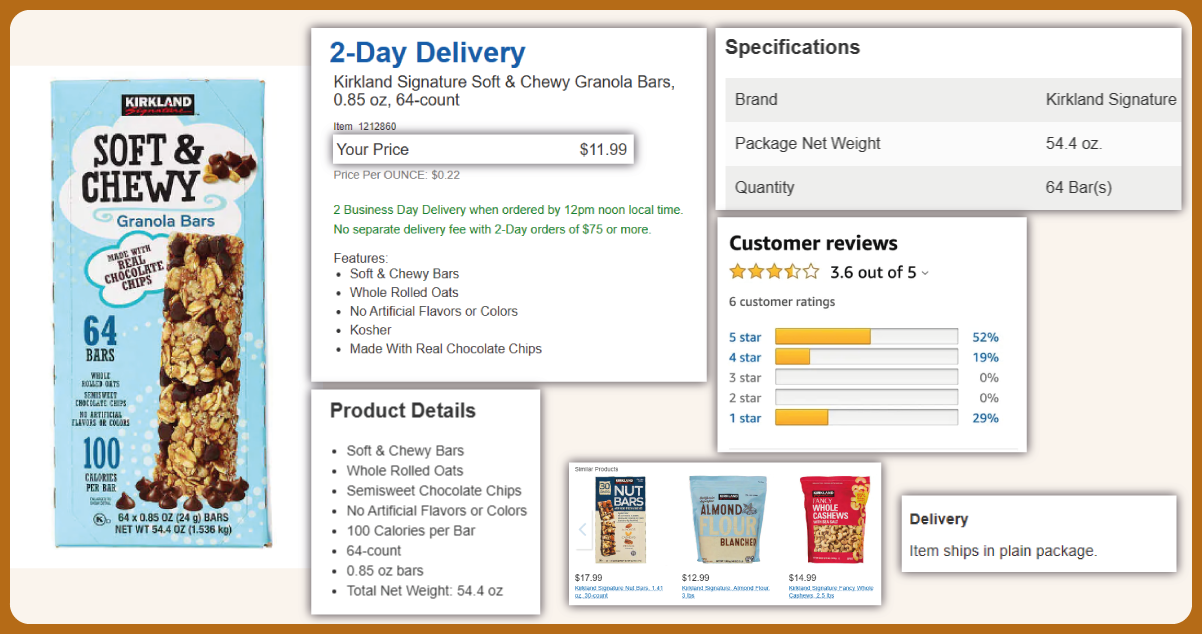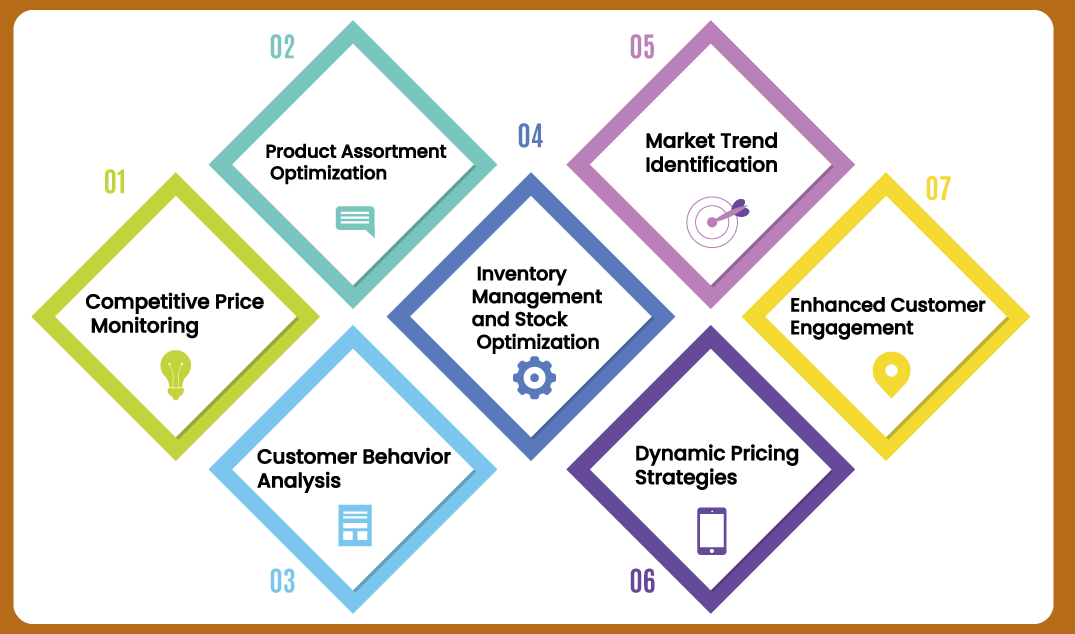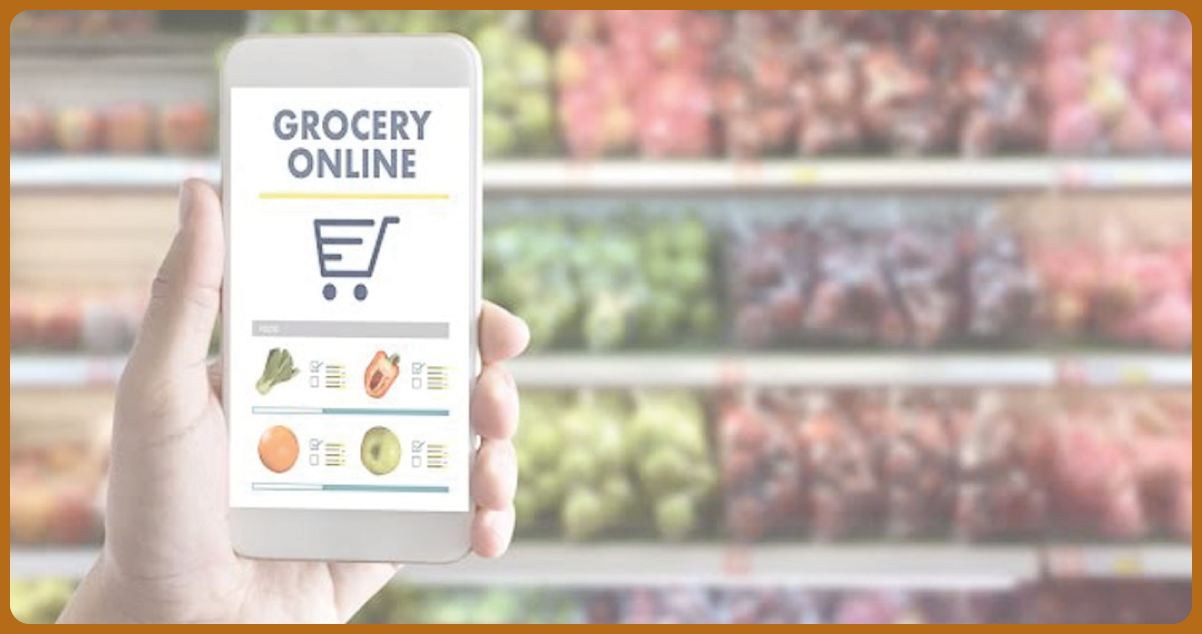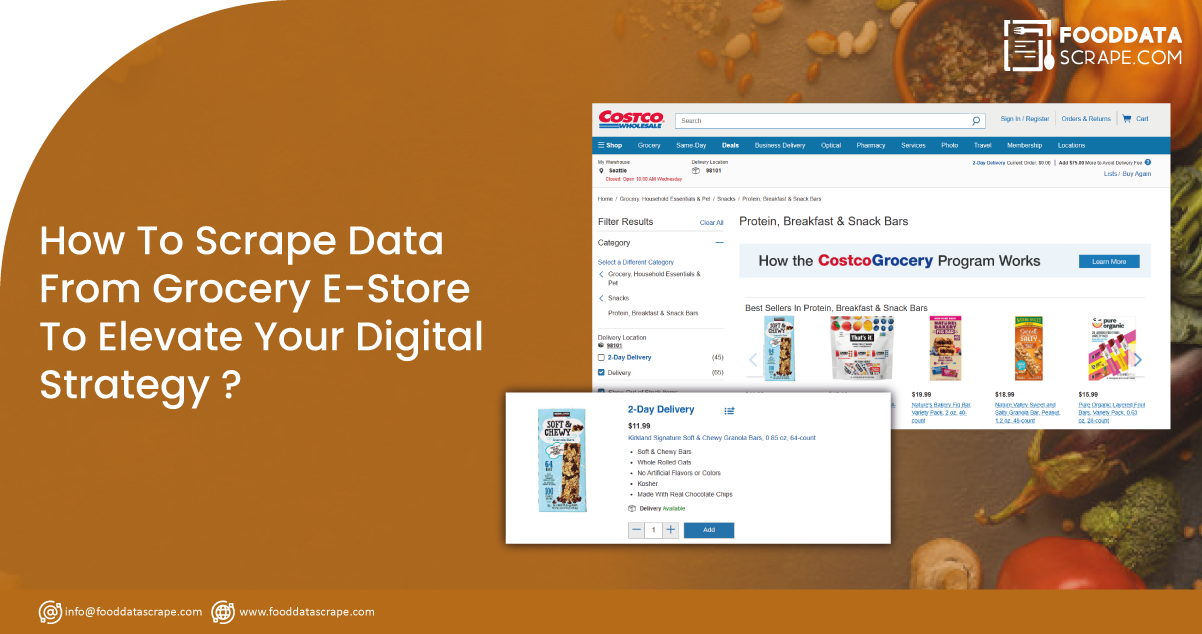The emergence of digital retail has triggered a profound shift in consumer behavior worldwide, altering expectations and reshaping the dynamics of the food and grocery market.
Forecasts project a substantial $223 billion digital grocery market in the US by 2025, propelled by pandemic-induced shifts and inflation, driving a surge in online shoppers seeking convenience and competitive prices. Leading grocery and CPG/FMCG brands have strategically entrenched themselves in eCommerce platforms, maintaining a solid presence across popular marketplaces, DTC websites, and grocery apps.
List of Data Fields

Product Details:
- Product Name
- Product ID or SKU
- Brand
- Category
- Description
- Weight/Volume
Pricing Information:
- Regular Price
- Sale Price (if applicable)
- Discount Percentage
- Unit Price
- Currency
Stock and Availability:
- Stock Quantity
- In-Stock/Out-of-Stock Status
- Delivery Time
- Availability Status
Customer Reviews:
- Customer Ratings
Reviews Text
- Reviewer Username
- Review Date
Product Images:
- URLs or links to product images
- Image Alt Text
Nutritional Information:
- Nutritional Facts (calories, fat, protein, etc.)
- Ingredients
Product Variants:
- Different Variants (sizes, colors, flavors)
- Variant Prices and Availability
Promotional Information:
- Promotional Labels (e.g., "New Arrival," "Best Seller")
- Promotional Offers and Discounts
Shipping Information:
- Shipping Costs
- Shipping Methods
- Delivery Areas
Brand Information:
- Brand Details
- Brand Logo
- Brand Description
Customer Information:
- Customer Demographics (if available)
- Customer Preferences
Website Structure:
- URL Structure
- Navigation Hierarchy
Challenges and Strategic Pursuits:

However, since 2022, online grocery prices have outpaced other eCommerce categories, necessitating competitive alternatives for cost-conscious digital shoppers, notably millennials. Grocery retailers actively pursue effective, reliable, and profitable digital strategies, rigorously testing retail management systems to meet demand and stay ahead of competitors. Success in this rapidly evolving industry hinges on quality, pricing, convenience versus loyalty, using grocery data scraping, and navigating the delicate balance between private labels and beloved brands.
In the era of digital retail, establishing a robust online presence is imperative for grocery e-stores seeking to stay ahead of the curve. One innovative approach to gaining a competitive edge is scraping grocery data, a powerful technique that involves extracting valuable data from top e-commerce websites. Here's how to level up your grocery e-store's digital strategy with grocery data scraping services.
1. Competitive Price Monitoring:
Grocery data scraper allows you to monitor and analyze the pricing strategies of top e-commerce players in the grocery industry. By extracting real-time pricing data from competitors, you can adjust your prices strategically, ensuring competitiveness while maximizing profitability.
2. Product Assortment Optimization:
Scraping data from e-commerce platforms enables you to analyze popular products and trends. Utilize this information to optimize your product assortment, ensuring that your grocery e-store offers in-demand items that align with consumer preferences.
3. Customer Behavior Analysis:
Scrape data from grocery e-store to understand customer behavior for tailoring your e-store's user experience. Web scraping enables you to collect and analyze data on customer preferences, purchase patterns, and feedback from top e-commerce websites. This insight can inform personalized marketing strategies and enhance customer satisfaction.
4. Inventory Management and Stock Optimization:
Web scraping grocery data helps monitor inventory levels and stock availability across various e-commerce platforms. This data can optimize your inventory management, ensuring timely restocking of popular items and minimizing product shortages.
5. Market Trend Identification:
You gain valuable insights into emerging market trends by scraping data from top grocery e-commerce websites. This information empowers you to stay ahead of the curve, introducing new products or adjusting marketing strategies to align with evolving consumer preferences.
6. Dynamic Pricing Strategies:
Web scraping allows for extracting dynamic pricing information, helping you implement responsive pricing strategies. Adjust prices based on demand, seasonality, or competitor actions, ensuring your grocery e-store remains agile in a dynamic market.
7. Enhanced Customer Engagement:
Utilize scraped data to personalize your communication with customers. Tailor marketing campaigns, promotions, and loyalty programs based on customer preferences, creating a more engaging and relevant shopping experience.
Strategies for Success in the Digital Grocery Industry

The digital transformation of the grocery industry has ushered in a new era, demanding innovative strategies for success. Here are the seven key pillars that form the foundation for thriving in the dynamic landscape of digital grocery.
1. Seamless User Experience: A successful digital grocery platform begins with a seamless user experience. Prioritize a user-friendly interface, intuitive navigation, and mobile responsiveness. Optimize the product discovery process, simplify checkout procedures, and provide responsive customer support, ensuring a delightful shopping journey.
2. Comprehensive Product Assortment: Diversity in product offerings is crucial. Regularly analyze market trends and customer preferences to curate a comprehensive product assortment. Align your inventory with evolving demands, ensuring a wide range of high-quality products that meet varying customer needs.
3. Efficient Supply Chain Management: An efficient supply chain is fundamental for success. Implement advanced inventory management systems for real-time tracking, ensuring timely restocking. Optimize logistics to guarantee swift and reliable delivery services, meeting customer expectations for convenience and reliability.
4. Data-Driven Decision Making: Leverage data analytics for informed decision-making. Analyze customer behavior to understand preferences and optimize the user experience. Monitor sales trends and gather insights from competitor activities, enabling strategic decisions on pricing, promotions, and marketing campaigns.
5. Personalized Marketing Strategies: Tailor marketing efforts based on individual customer preferences. Utilize data to create personalized promotions, targeted recommendations, and effective loyalty programs. This personalized approach enhances customer engagement, fosters brand loyalty, and increases lifetime value.
6. Technological Integration: Stay at the forefront of technology adoption. Embrace innovations like artificial intelligence, machine learning, and data scraping to streamline operations. Implement advanced technologies to improve customer experiences, enhance efficiency, and stay ahead of industry trends.
7. Adaptive Pricing Strategies: Implement dynamic pricing strategies that respond to market fluctuations and customer behavior. Regularly monitor competitor pricing through web scraping, adjusting your prices to remain competitive while ensuring profitability. This adaptability ensures that your digital grocery platform remains responsive to the dynamic nature of the market.
Pioneering Grocery Retailers of 2023
In the dynamic landscape of the grocery industry, success hinges on strategic resource allocation and a commitment to critical pillars. Let's delve into the achievements of six prominent American grocery retailers, each excelling in distinct areas.
Walmart: Renowned for its Everyday Low Price (EDLP) strategy, Walmart prioritizes offering year-round low prices, fostering customer loyalty. This approach, coupled with direct sourcing, minimizes costs, boosts sales, and enhances its thriving online marketplace, making it a global budget-friendly shopping destination. Scrape Walmart product data to gain comprehensive insights into pricing trends, product availability, customer reviews, and competitor strategies. This valuable data can inform pricing strategies, inventory management, and market positioning, enabling businesses to make informed decisions and stay competitive in the dynamic retail landscape.
Trader Joe's: As a specialty grocer, Trader Joe's stands out for its focus on value perception through low prices and high quality. The retailer operates without an online presence and channels resources into an exceptional in-store experience. Trader Joe's cultivates a unique niche with a vast range of private-label products, building unbreakable connections with budget-conscious families. Scrape Trader Joe's product data to extract detailed information on product listings, prices, customer reviews, and availability. Analyzing this data provides valuable insights into market trends, helps optimize pricing strategies, and allows businesses to stay informed about the product landscape at Trader Joe's, aiding in strategic decision-making and competitive positioning.
Wegmans: Praised for top-quality offerings and a stellar in-store experience, Wegmans emphasizes a trade-off by not leading in pricing. Its commitment to high-quality items has earned it the title of "America's favorite grocery retailer," showcasing the power of prioritizing perceived value over unbeatable prices. Scrape Wegmans product data to help collect product details, pricing, customer reviews, and availability information. This data can offer valuable insights into market trends, aid in formulating effective pricing strategies, and keep businesses informed about the product landscape at Wegmans. Utilizing this scraped data enables informed decision-making and enhances competitive positioning in the retail sector.
Costco: A bulk retailer excelling in pricing, quality, digital, and operations, Costco stands out with massive aisles of discounted essentials. With a focus on bulk purchasing, it prioritizes national brands and private-label Kirkland Signature products. Maintaining an online presence, Costco caters to a diverse consumer base and incentivizes membership through exclusive benefits. Scrape Costco product data to retrieve comprehensive product details, pricing, customer reviews, and stock availability information. Analyzing this data provides valuable insights into market trends, assists in optimizing pricing strategies, and keeps businesses well-informed about the diverse product offerings at Costco. The scraped data enables strategic decision-making, fostering a competitive edge in the dynamic retail environment.
Amazon Fresh: The digital giant, leveraging its Prime membership perks and cost comparisons, applies a tested playbook to undercut competitors' prices. Despite ranking low in quality or convenience, Amazon Fresh captures market share through its seamless online shopping experience and efficient delivery network, securing its position as a formidable competitor. Scrape Amazon Fresh product data to extract detailed information on product listings, prices, customer reviews, and availability. This data offers valuable insights into market trends, aids in optimizing pricing strategies, and keeps businesses informed about the diverse product landscape on Amazon Fresh. Leveraging this scraped data enables businesses to make informed decisions, enhance their competitive positioning, and stay adaptive in the evolving online grocery market.
Kroger: As one of the largest grocery chains, Kroger offers various products and services, from groceries to pharmaceuticals. Its cost-effective warehouse-style stores and intuitive digital storefront, offering swift 30-minute deliveries, cater to diverse customer needs. The innovative "fuel points" system further enhances customer engagement, encouraging loyalty through strategic incentives. Scrape Kroger product data to retrieve essential product details, pricing, customer reviews, and stock availability information. Analyzing this data provides valuable insights into market trends, helps in formulating effective pricing strategies, and keeps businesses well-informed about the diverse product offerings at Kroger. The scraped data facilitates informed decision-making, contributing to a competitive edge in the dynamic retail landscape.
Elevating Digital Shopping Experience: Strategies for Success in the Grocery Industry

The digital shelf has emerged as a pivotal source for pricing and product data, presenting a competitive landscape for retailers. To incentivize digital shoppers, retailers must navigate the challenges a discerning consumer base poses. As the shift to eCommerce platforms continues, creating high-value perception becomes paramount
Capitalizing on Flexible Delivery Options:
In response to increasing prices, retailers can attract shoppers by offering savings through flexible delivery options. Prioritizing convenience with user-friendly e-stores and adaptable payment plans becomes essential, enabling retailers to formulate pricing strategies and discounts that align with budget-conscious consumers.
The Rise of Smaller Retailers:
Smaller players like FreshDirect and NetGrocer have carved significant niches in the online grocery delivery market, showcasing the competitiveness of smaller businesses against industry giants. Strategic partnerships with delivery services like Doordash and Instacart and innovative services like curbside pickups contribute to alternative sales growth, emphasizing the importance of an omnichannel presence.
Tech Strategies for Optimization:
Beyond robot cashiers, technology plays a pivotal role in optimizing results for grocers. From data analytics to dynamic pricing, technology facilitates forward-thinking initiatives such as assortment planning, customer insights, and promotion optimization. With its ability to adapt prices in real-time, dynamic pricing emerges as a powerful tool, exemplified by industry leaders like Amazon.
Data-Driven Decision Making:
Amid price wars, data analytics remains a critical component for retailers. Leveraging solutions like price optimization software streamlines the process, automating retail pricing and inventory management. By analyzing market trends and utilizing AI-driven technology to assess price elasticity and competitive pricing, retailers can make informed decisions to enhance their competitive advantage.
Remaining Competitive Amidst Price Wars:
Surviving in the grocery industry requires a nuanced approach. Trader Joe's, Wegmans, Amazon, Costco, and others have risen to the top through superior business models prioritizing emotional connection and financial performance. As the industry evolves, a commitment to innovation, technological integration, and strategic partnerships will continue to shape the success stories of grocery retailers in the digital era.
Conclusion:
Grocery data scraping elevates a grocery store's digital strategy. Businesses can optimize their online presence by extracting vital insights on pricing, product trends, and customer behavior. This data-driven approach facilitates informed decision-making, allowing for adaptive pricing strategies, personalized marketing, and enhanced user experiences. With a finger on the pulse of market dynamics, grocery retailers can stay competitive, efficiently manage inventory, and tailor their strategies to meet evolving customer expectations. Grocery data scraping emerges as a powerful tool, propelling e-stores to new heights by unlocking actionable intelligence for strategic growth.
Unlock unparalleled insights by partnering with Food Data Scrape. Our expertise lies in Food Data Aggregator and Mobile Grocery App Scraping service, providing in-depth data insights and analytics to enhance decision-making and elevate business strategies. Contact us today to embark on a journey to success guided by data-driven intelligence.






























































































